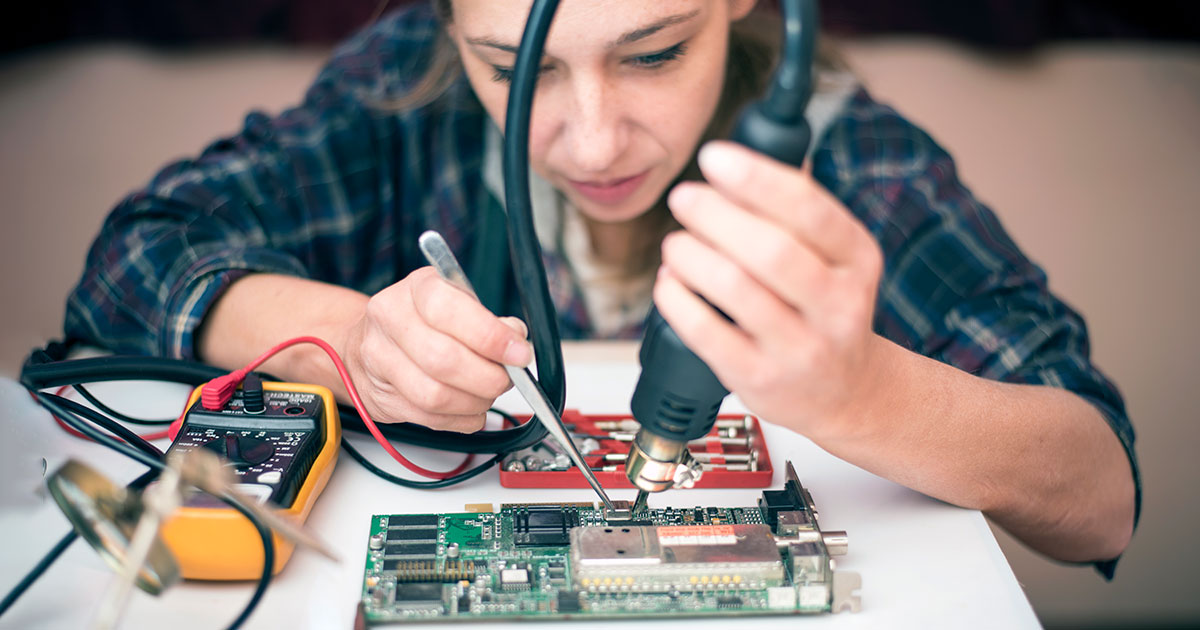
March 16, 2022 – Gone are the days when the only things a farmer needed to repair a diesel engine was a set of wrenches, a repair manual, and a willingness to lose some knuckle skin.
“It used to be that you could pop open the hood, get some grease under your fingernails, and figure out what was wrong with a tractor,” said Kevin O’Reilly, Right-to-Repair director for U.S. PIRG, a national public-interest advocacy group.
Today, repairing the computerized engines found in tractors, trucks, and cars requires expensive diagnostic equipment and, increasingly, codes to unlock security and environmental features installed by manufacturers.
“As software has worked its way into everything we use on a daily basis, manufacturers have really taken control of the repair process,” O’Reilly said.
A debate over the proper extent of that control has sparked a nationwide right-to-repair movement, one that pits farmers, equipment owners, and repair contractors against equipment manufacturers and dealers.
Costly Downtime
Blog entries on the U.S. PIRG website detail some of the problems that have given rise to the movement.
 Jeff M. Brown is a legal writer for the State Bar of Wisconsin, Madison. He can be reached by email or by phone at (608) 250-6126.
Jeff M. Brown is a legal writer for the State Bar of Wisconsin, Madison. He can be reached by email or by phone at (608) 250-6126.
Error codes generated by a tractor’s computer – say because the emissions system is malfunctioning – can trigger a reduction in power to the point where the machine can’t do its job. To diagnose the problem behind the code often requires software tools – tools that manufacturers allow only authorized dealers or repair shops to access.
Waiting for a dealer or authorized repair shop to make a house call – or for major repairs, having the tractor trucked to the dealer – can cost a farmer precious time, especially during seedtime and harvest.
Adding to the problem, O’Reilly said, is a decrease in the number of locally-owned dealers, a dynamic driven by corporate consolidation.
“More and more these dealers are part of big large chains. The moms and pops of the world are disappearing. Instead, it’s these huge conglomerates.”
The resulting lack of competition boosts repair costs.
“They often dominate regions of states, so that even if you have multiple dealers within driving range those dealerships might all belong to the same chain group, which means you’re not really getting a competitive piece,” O’Reilly said. “All of that leaves famers more or less with their hands tied.
“When it comes to planting, when it comes to harvesting, those are really critical windows – if there’s a breakdown that happens, you need to get your equipment back up and running stat.”
‘Caught in the Middle’
Laura Brenner, a shareholder at Reinhart Boerner Van Deuren S.C. in Milwaukee, represents clients on both sides of the right-to-repair issue.
Brenner said the Magnuson-Moss Warranty Act (MMWA) provides some protection for consumers who need repairs to their equipment.
Under the MMWA, manufacturers may not tie warranty coverage to using a specific brand or provider or parts or services, unless the manufacturer provides the parts or services free of charge.
“Even within that law, if it’s something that the manufacturer is paying for under the warranty, they can determine how the repairs are going to be done,” Brenner said.
But when a vehicle is out of warranty, Brenner said, “we’re all used to taking it to our favorite mechanic down the street.”
Manufacturer control over the repair process threatens to upend that expectation, Brenner said.
“You’re worried about limited choice and you’re worried about price … Are we going to lose some independent service repair businesses who can no longer take care of these things?”
According to Brenner, repair shops are caught in the middle.
“They want to do the repair work, but they want to know if they are authorized to do the repairs on particular products. They have to ask, ‘am I breaching somebody’s license agreement? What happens if I mess it up? Do I have access to the right tools?’”

“Right-to-repair is just a commonsense solution to this problem. When things are broken we should fix them. When things are broken, we should enable people to fix them.” – Kevin O’Reilly, Right-to-Repair director for U.S. PIRG, a national public-interest advocacy group.
More than Just Tractors
Brenner said the right-to-repair issue reaches beyond America’s amber waves of grain.
“As we introduce more technology into everyday things, these problems could apply to many items. It could be your refrigerator, it could be your stove.”
It could also be your ventilator.
At the height of the COVID-19 pandemic, hospitals across America struggled to keep the nation’s scarce supply of overworked ventilators in good repair.
Manufacturer requirements made the struggle more daunting. Only technicians who’d received expensive training from the manufacturer and maintained multiple manufacturer-specific certifications could service them.
According to Business Insider, manufacturers won’t provide manuals to technicians who haven’t received the training. Even after their technicians completed the training, hospitals must pay subscription fees for the manuals.
“This pandemic should have been a moment where we had all hands on deck, where all parties were working together to save as many lives as we could, to deliver the best care possible to patients. Instead, what we saw was a lot of manufacturers continuing to lock out qualified hospital technicians fixing necessary equipment like ventilators and dialysis machines,” O’Reilly said.
O’Reilly said that in response to a public outcry, three ventilator manufacturers eventually delivered manuals and materials necessary to repair their ventilators.
“But here we are two years in, and I’m still talking to folks working in hospitals who have broken equipment sitting on a shelf just because they can’t get access to what they need to fix it.”
Ballot Measure Addressed Auto Repairs
Losing time and money because of a stalled tractor might sound foreign to car owners, many of whom take their cars to independent repair shops and receive speedy service with little hassle.
The reason for that, O’Reilly said, is a memorandum of agreement (MOA) signed by the big three automobile manufacturers after the passage of a ballot measure in Massachusetts in November 2012.
The measure required manufacturers to grant owners and independent repair shops in Massachusetts the same access to diagnostic and repair information that they grant dealers and authorized repair shops. It passed with 86% of the vote.
“That’s why – even though your modern car might have thousands and thousands of lines of code in it, you can walk into an O’Reilly Auto Parts and buy a Snap-On tool for $10 or $15 to plug in to your diagnostic system and see why your ‘Check engine’ light is on,” O’Reilly said.
Rather than take on the cost of building one set of vehicles that complied with the Massachusetts law and one set that didn’t, O’Reilly said, the manufactures agreed to build all their vehicles to comply with the Massachusetts law.
Passage of the ballot measure allowed Massachusetts law set a national standard for access to diagnostic and repair information in the same way that California law has long set the national standard for vehicle emissions standards.
Adoption of the Massachusetts ballot measure signals that the right to repair is popular with consumers, O’Reilly said.
“The big takeaway from that as far as right-to-repair with tractors, or with smart phones, or with household appliances and medical devices like ventilators, this problem exists across the board. And what we saw with that new ballot measure is, again, this is something that the public broadly supports.”

“From a manufacturer’s position, they want to control the situation because they are asking, “How do I make sure my consumers are getting the best repair services?’ because this is complex.” – Laura Brenner, a shareholder at Reinhart Boerner Van Deuren S.C. in Milwaukee, represents clients on both sides of the right-to-repair issue.
Right-to-Repair Bills in Congress
Farm equipment manufacturers were not a party to the MOA, so right-to-repair remains an issue for farmers. Members of Congress have taken note, introducing two right-to-repair bills last month.
In the House of Representatives, Reps. Mondaire Jones (D-NY) and Victoria Spartz (R-IN) introduced the Freedom to Repair Act (HR 6566).
The bill would amend the 1998 Digital Millennium Copyright Act, a provision of which makes bypassing digital security locks a crime. That provision means that a repair contractor who relies on state right-to-repair laws to legally access a manufacturer’s repair codes end up committing a copyright violation.
In the U.S Senate, Senator Jon Tester (D-MT) – himself a farmer – introduced the Agricultural Right to Repair Act. To ensure that farmers are able to repair their equipment, the bill would impose the following requirements on manufacturers of farm equipment:
Provide farmers with documentation, parts, software and tools necessary to diagnosis, maintenance or repairs;
Allow farmers to disable and re-enable security locks or other security functions that affect diagnostics, repairs, or maintenance;
Allow interoperability between third-party software and other parts or tools;
Protect farmer’s data and equipment from hackers;
Either use parts that are replaceable with widely available tools that won’t damage the equipment, or provide on fair and reasonable terms specialized tools to owners and independent repair contractors.
The bill also specifies that the copyrights and patents for discontinued documentation, parts, software, and tools become part of the public domain, and that farmers own the data generated by their equipment.
State legislatures are getting in on the act too.
According to O’Reilly, 27 states introduced right to repair legislation in 2021. So far in 2022, 19 states have either introduced or held over right to repair legislation. Wisconsin is not among those states but Illinois and Minnesota are.
Action by Biden, FTC
The executive branch is also moving to address the right-to-repair issue.
Last July, President Biden issued an executive order aimed at increasing competition throughout the economy. Among other things, the order directs the Federal Trade Commission (FTC) to promulgate administrative rules curtailing the right of manufacturers to limit independent repairs.
Biden issued the order two months after the FTC released a 54-page report entitled “Nixing the Fix: An FTC Report to Congress on Repair Restrictions.”
According to the report, consumer problems caused by repair restrictions were exacerbated by the pandemic, which forced many adults to work from home and many children into remote learning.
The increase in computer use caused a repair boom, and repair restrictions meant that “people have been forced to send their devices to authorized repair facilities—often waiting weeks for them to be returned,” the report said.
In the report, the FTC concluded that repair restrictions have watered down the anti-tying provisions of the MMWA – provisions that prohibit warrantors from conditioning warranties on using brand name repairs, unless the repairs are free. Additionally, the report concluded that “there is scant evidence to support manufacturers’ justifications for repair restrictions.”
'This is Complex'
But in a footnote, the FTC report acknowledged that two commissioners pointed out that the report didn’t take into account manufacturer’s IP rights, “which may provide legitimate justification for some repair restrictions.”
Brenner said that the IP issue is largely a consequence of the increasing reach of technology.
“It wasn’t a concern before because we could all open up an engine and look in and there wasn’t really anything that was a trade secret or copyrighted. Now, when you’re talking about software, when you’re talking about things that are copyrighted, of course manufacturers have some serious concerns that they may not have had before.”
Repair restrictions also help manufacturers ensure that customers receive proper repairs, Brenner said.
“From a manufacturer’s position, they want to control the situation because they are asking, “How do I make sure my consumers are getting the best repair services?’ because this is complex.”
Manufacturers have also claimed that repair restrictions are necessary to ensure that owners or independent mechanics don’t disable components that manufacturers are required to include in equipment, such as emissions controls in tractors.
“How do you balance that against the consumer saying ‘I want to have some freedom to decide who’s going to make some repairs on my item,” Brenner said. “It’s an interesting crossroads that I don’t think we’ve faced before.”
What Next?
Brenner said the threat of legislation has forced some auto companies to allow dealers and independent repair shops to access the tools necessary to repair proprietary systems. But she said that ultimately, laws and regulations designed to give consumers broader rights to repair their equipment may end up costing them.
For instance, manufacturers will have to spend money on lawyers to interpret new laws and regulations, and to possibly file lawsuits to test the bounds of the new laws. There have already been five class action suits filed against John Deere, claiming that the manufacturer’s repair restrictions violate the Sherman Antitrust Act.
“And then of course if there’s a state law and federal law, then you’re trying to figure out how to comply with both, it can be tough,” Brenner said. “Sometimes it’s better if the solutions are developed by businesses themselves because they do really know their stuff.”
How does Brenner see the right-to-repair issue playing out?
“I think it’s going to go one of two ways: either manufacturers handle it in a fair way so that the consumer prices don’t go up substantially, or we’re going to see the federal and state governments step in with new laws because they are receiving too many complaints from customers and small businesses.”
For O’Reilly, the right to repair one’s equipment should be included in the purchase price.
“Right-to-repair is just a commonsense solution to this problem. When things are broken we should fix them. When things are broken, we should enable people to fix them.”
Brenner said that the pace of technological change means that the right to repair issue is likely here to stay.
“It’s changing so quickly. Sometimes the laws just can’t keep up. And sometimes it’s not until people yell that things get reined in a little bit.”
